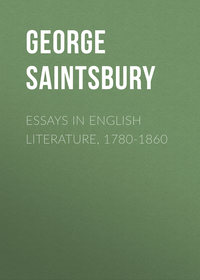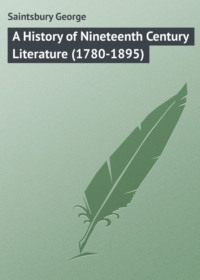 полная версия
полная версияПолная версия
A Short History of French Literature
Furetière.
Charles Sorel, an exceedingly voluminous author, historiographer of France, deserves mention in passing for his Histoire Comique de Francion247, in which, as in almost all the fictitious work of the time, serious as well as comic, living persons are introduced. The chief remarkable thing about Francion is the evidence it gives of an attempt at an early date (1623) to write a novel of ordinary manners. It is a dull story with loose episodes. More interesting is Antoine Furetière, author of the Roman Bourgeois248. Furetière, who was a man of varied talent, holds no small place in the history of the calamities of authors. He wrote poems, short tales, fables, satires, criticisms. He is said to have given both Boileau and Racine not inconsiderable assistance. Unfortunately for him, though he had been elected an academician in 1662, he conceived and executed the idea of outstripping his tardy colleagues in their dictionary work. He produced a book of great merit and utility, but one which brought grave troubles on his own head. It was alleged that he had infringed the privileges of the Academy; he was expelled from that body, his own privilege for his own book was revoked, and it was not published till after his death, becoming eventually the well-known Dictionnaire de Trévoux. Furetière's side has been warmly taken in these days, and it has been sought, not without success, to free him from the charge of all impropriety of conduct, except the impropriety of continuing to be a member of the Academy, while what he was doing could hardly be regarded as anything but a slight on it. The Roman Bourgeois is an original and lively book, without any general plot, but containing a series of very amusing pictures of the Parisian middle-class society of the day, with many curious traits of language and manners. It was published in 1666.
Madame de la Fayette.
Of very different importance is the Countess de la Fayette, who has the credit, and justly, of substituting for mere romances of adventure on the one hand, and for stilted heroic work on the other, fiction in which the display of character is held of chief account. In the school, indeed, of which Scarron set the example in France, especially in Gil Blas, its masterpiece, the most accurate knowledge and drawing of human motives and actions is to be found. But it is knowledge and drawing of human motives and actions in the gross rather than in particular. Gil Blas, and even Tom Jones, are types rather than individuals, though the genius of their creators hides the fact. It is, perhaps, an arguable point of literary criticism, whether the persevering analysis of individual, and more or less unusual, character does not lead novelists away from the best path – as it certainly leads in the long run to monstrosities of the modern French and English 'realist' type. But this is a detail of criticism into which there is no need to enter here. It is sufficient that the style has produced some of the most admirable, and much of the most characteristic, work of the last century, and that Madame de la Fayette is on the whole entitled to the credit of being its originator. Her pen was taken up in the next century by the Abbé Prevost and by Richardson, and from these three the novel, as opposed to the romance, may be said to descend. The maiden name of Madame de la Fayette249 was Marie Madeleine Pioche de la Vergne, and she was born at Paris in 1634. Her father was governor of Havre. She was carefully brought up under Ménage and Rapin, among others, and was one of the most brilliant of the précieuses of the Hôtel Rambouillet. In 1655 she married the Count de la Fayette, but was soon left a widow. After his death she contracted a kind of Platonic friendship with La Rochefoucauld, who was then in the decline of life, tormented with gout, and consoling himself for the departure of the days when he was one of the most important men in France by the composition of his undying Maxims. She survived him thirteen years, and died herself in 1693. During the whole of her life she was on the most intimate terms with Madame de Sévigné, as well as with many of the foremost men of letters of the time. In particular there are extant a large number of letters between her and Huet, bishop of Avranches, one of the most learned, amiable, and upright prelates of the age. Her first attempt at novel-writing was La Princesse de Montpensier. This was followed by Zaïde, published in 1670, a book of considerable excellence; and this in its turn by La Princesse de Clèves, published in 1677, which is one of the classics of French literature. The book is but a small one, not amounting in size to a single volume of a modern English novel, and this must of itself have been no small novelty and relief after the portentous bulk of the Scudéry romances. Its scene is laid at the court of Henri II., and there is a certain historical basis; but the principal personages are drawn from the author's own experience, herself being the heroine, her husband the Prince of Clèves, and Rochefoucauld the Duke de Nemours, while other characters are identified with Louis XIV. and his courtiers by industrious compilers of 'keys.' If, however, the interest of the book had been limited to this it would now-a-days have lost all its attraction, or have retained so much at most as is due to simple curiosity. But it has far higher merits, and what may be called its court apparatus, and the multitude of small details about court business, are rather drawbacks to it now. Such charm as it has is derived from the strict verisimilitude of the character drawing, and the fidelity with which the emotions are represented. This interest may, indeed, appear thin to a modern reader fresh from the works of those who have profited by two centuries of progress in the way which Madame de la Fayette opened. But when it is remembered that her book appeared thirty years before Gil Blas, forty before the masterpieces of Defoe, and more than half a century before the English novel properly so called made its first appearance, her right to the place she occupied will hardly be contested250.
The precise origin of the fancy for writing fairy stories, which took possession of polite society in France at the end of the seventeenth century, has been the subject of much discussion, and cannot be said to have been finally settled. Probably the fables of La Fontaine, which are very closely allied to the style, may have given the required impulse. As soon as an example was set this style was seen to lend itself very well to the still surviving fancy for coterie compositions, and the total amount of work of the kind produced in the last years of the seventeenth and the first of the eighteenth century must be enormous. Much of it has not yet been printed, and the names of but few of the authors are generally known, or perhaps worth knowing251. Three, however, emerge from the mass and deserve attention – Anthony Hamilton, Madame d'Aulnoy, and above all, Charles Perrault, the master beyond all comparison of the style.
Fairy Tales.
Marie Catherine, Comtesse d'Aulnoy, was born about the middle of the seventeenth century, and died in 1720. It is sufficient to say that among her works are the 'Yellow Dwarf' and the 'White Cat,' stories which no doubt she did not invent, but to which she has given their permanent and well-known form. She wrote much else, memoirs and novels which were bad imitations of the style of Madame de la Fayette, but her fairy tales alone are of value. Anthony Hamilton was one of the rare authors who acquire a durable reputation by writing in a language which is not their native tongue. He was born in Ireland in 1646, and followed the fortunes of the exiled royal family. He returned with Charles II., but adhering to Catholicism, was excluded from preferment in England until James II.'s reign, and he passed most of his time before the Revolution, and all of it afterwards, in France. Hamilton produced (besides many fugitive poems and minor pieces) two books of great note in French, the Mémoires de Grammont, his brother-in-law, which perhaps is the standard book for the manners of the court of Charles II., and a collection of fairy tales, less simple than those of Perrault and Madame d'Aulnoy and more subordinated to a sarcastic intention, but full of wit and written in French, which is only more piquant for its very slight touch of a foreign element. Many phrases of Hamilton's tales have passed into ordinary quotation, notably 'Bélier, mon ami, tu me ferais plaisir si tu voulais commencer par le commencement.'
Perrault.
The master of the style was, however, as has been said, Charles Perrault, whose literary history was peculiar. He was born at Paris in 1628, being the son of Pierre Perrault, a lawyer, who had three other sons, all of them of some distinction, and one of them, Claude Perrault, famous in the oddly conjoined professions of medicine and architecture. Charles was well educated at the Collège de Beauvais, and at first studied law, but his father soon afterwards bought a place of value in the financial department, and Charles was appointed clerk in 1662. He received a curious and rather nondescript preferment (as secretary to Colbert for all matters dependent on literature and arts), which, among other things, enabled him to further his brother's architectural career. In 1671 he was, under the patronage of Colbert, elected of the Academy, into the affairs and proceedings of which he imported order almost for the first time. He had done and for some time did little in literature, being occupied by the duties which, under Colbert, he had as controller of public works. But after a few essays in poetry, partly burlesque and partly serious, notably a Siècle de Louis XIV., he embarked on the rather unlucky work which gave him his chief reputation among his own contemporaries, the Parallèle des Anciens et des Modernes, in which he took the part of the moderns. The dispute which followed, due principally to the overbearing rudeness of Boileau, has had something more than its proper place in literary history, and there is no need to give an account of it. It is enough to say that while Boileau as far as his knowledge went (and that was not far, for he knew nothing of English, not very much of Greek, and it would seem little of Italian or Spanish) had the better case, Perrault, assisted by his brother, made a good deal the best use of his weapons, Boileau's unlucky 'Ode on Namur' giving his enemies a great hold on him. After six years' fighting, however, the enemies made peace, and, indeed, it does not seem that Perrault at any time bore malice. He produced, besides some memoirs and the charming trifles to be presently spoken of252, a good many miscellanies in prose and verse of no particular value, and died in 1703.
His first tale, Griselidis (in verse, and by no means his best), appeared in 1691, Peau d'Âne and Les Souhaits Ridicules in 1694, La Belle au Bois Dormant in 1696, and the rest in 1697. These are Le Petit Chaperon Rouge, La Barbe Bleue, Le Maître Chat ou le Chat Botté, Les Fées, Cendrillon, Riquet à la Houppe, and Le Petit Poucet. It is needless to say that Perrault did not invent the subjects of them. What he contributed was an admirable and peculiar narrative style, due, as seems very probable, in great part to the example of La Fontaine, but distinguished therefrom by all the difference of verse and prose. The characteristics of this style are an extreme simplicity which does not degenerate into puerility, great directness, and at the same time vividness in telling the story, and a remarkable undercurrent of wit which is never obtrusive, as is sometimes the case in the verse tales. Perrault's stories deserve their immense popularity, and they found innumerable imitators chiefly among persons of quality, who, as M. Honoré Bonhomme, the best authority on the obscurer fairy-tale writers, observes, probably found an attraction in the style because of the way in which it lent itself to cover personal satire. This, however, is something of an abuse, and little or nothing of it is discernible in Perrault's own work, though later, and especially in the eighteenth century, it was frequently if not invariably present.
Note to the last Three Chapters.
Although the list of names mentioned here under the respective heads of poets, dramatists, and novelists is considerable, it is very far indeed from being exhaustive. It may, indeed, be said generally that it is only possible in this history, especially as we leave the invention of printing farther and farther behind, to mention those names which have left something like a memory behind them. The dramas and novels of the seventeenth century are extremely numerous, and have been but very partially explored. In regard to the poems there is an additional difficulty. It was a fashion of the time to collect such things in recueils– miscellaneous collections – in which the work of very large numbers of writers, who never published their poems separately or obtained after their own day any recognition as poets, is buried. Specimens, published here and there by the laborious editors of the greater classics in illustration of these latter, show that with leisure, opportunity, and critical discernment, this little-worked vein might be followed up not without advantage. But for such a purpose, as for the similar exploration of many other out-of-the-way corners of this vast literature, conditions are needed which are eminently 'the gift of fortune.' These remarks apply more or less to all the following chapters and books of this history. But they may find an appropriate place here, not merely because it is from this period onwards that they are most applicable, but because this special department of French literary history – the earlier seventeenth century – contains, perhaps, the greatest proportion of this wreckage of time as yet unrummaged and unsorted by posterity.
CHAPTER IV
HISTORIANS, MEMOIR-WRITERS, LETTER-WRITERS
Although the seventeenth century did not witness the acceptance in France of what may be called a philosophical conception of history, and though few or none of the regular histories of the time (with the exception of that of Mézeray) hold high rank as literature, no period was more fruitful in memoirs, letters, and separate historical sketches of the first merit. The names of Madame de Sévigné, of the Cardinal de Retz, of La Rochefoucauld, and at the extreme end of the period of Saint Simon, rank among those of the most original writers of France, while the historical essay has rarely assumed a more thoroughly literary form than in the short sketches of Retz, Sarrasin, and others. The subject of the present chapter may, therefore, be divided into four parts, the historians properly so called (the least interesting of the four), the historical essayists, the memoir-writers, and the letter-writers, with an appendix of erudite cultivators of historical science and of miscellaneous authors of historical gossip and other matters.
General Historians. Mézeray.
253It is said not unfrequently that the only historical work of this particular period, combining magnitude of subject with elevation and originality of thought and literary excellence of expression, is Bossuet's discourse on universal history. There is not a little truth in the saying. Still there are a few authors whose work deserves mention. The great history of De Thou was written in Latin. But the century produced in Mézeray's History of France the first attempt of merit on the subject. François Eudes de Mézeray was the son of a surgeon, who seems to have been of some means and position. Mézeray was educated at Caen (he was born in 1610), and he early betook himself to historical studies. After beginning by supervising a translated history of the Turks, he set to work on his masterpiece, the History of France, which appeared in three huge and splendid folios in 1643, 1646, and 1651. He was accused of treating his predecessors with too great contempt; but this was more than justified by the superiority, not merely in style but in historical conception and attention to documentary evidence, which he showed. Mézeray had been protected and pensioned by Richelieu, but under Mazarin he became a violent pamphleteer and author of Mazarinades. Later, when Louis XIV. was settled on the throne, he published an abridgment of his own history, in which the keen scent of Colbert discovered uncourtly strictures on the fiscal abuses of the kingdom. Mézeray refused to alter them, and was mulcted accordingly of part of his pension. He died in 1683, having earned the title of the first historian, worthy of the name, of France. With due allowance for his period, he may challenge comparison with almost any of his successors, though his style, excellent at its best, is somewhat unequal. Péréfixe (who may have been assisted by Mézeray) is responsible for a history of Henri IV.; Maimbourg for a history of the League which has some interest for Englishmen because Dryden translated it. The same great English writer projected but did not accomplish a translation from a much more worthless historian, Varillas, who is notorious among his class for indifference to accuracy. It is indeed curious that this century, side by side with the most laborious investigators ever known, produced a school of historians who, with some merits of style, were almost deliberately unfaithful to fact. If the well-known saying ('Mon siége est fait') attributed to the Abbé Vertot is not apocryphal254, he must be ranked in the less respectable class. But his well-known histories, the chief of which is devoted to the Knights of Malta, were not wholly constructed on this principle. Pellisson wrote a history of the Academy, of which he was secretary, and one of the living Louis XIV., which, as might be expected, is little more than an ingenious panegyric. The Père Daniel wrote a history of France, the Père d'Orléans one of the English revolutions; while Rapin de Thoyras, a Huguenot and a refugee, had the glory of composing in a foreign language the first book deserving the title of a History of England. Superior to all these writers, except to Mézeray, are the ecclesiastical historians Fleury and Tillemont. Fleury was a good writer, very learned and exceedingly fair. Tillemont, with less pretentions to style, is second to no writer of history in learning, industry, accuracy, and judgment.
Historical Essayists.
Saint Réal.
The historical essay, like much else of value at the time, was in great part due to the mania for coteries. In these select societies literature was the favourite occupation, and ingenuity was ransacked to discover forms of composition admitting of treatment in brief space and of the display of literary skill. The personal 'portrait,' or elaborate prose character, was of this kind, but the ambition of the competitors soared higher than mere character-drawing. They sought for some striking event, if possible contemporary, which offered, within moderate compass, dramatic unity and scope for something like dramatic treatment. Sometimes, as in the Relation du Passage du Rhin, by the Count de Guiche, personal experiences formed the basis, but more frequently passages in the recent history of other nations were chosen. Of this kind was the Conspiration de Walstein of Sarrasin, which, though incomplete, is admirable in style. Better still is the Conjuration de Fiesque of the Cardinal de Retz, his first work, and one written when he was but seventeen. Not a few of the scattered writings of Saint Evremond may be classed under this head, notably the Letter to Créqui on the Peace of the Pyrenees, which was the cause of his exile, though this was rather political than historical. Towards the end of the century, the Abbé Vertot preluded his larger histories by a short tract on the revolutions of Portugal, and another on those of Sweden, which had both merit and success. It will be observed that conspiracies, revolutions, and such-like events formed the staple subjects of these compositions. Of this class was the masterpiece of the style – the only one perhaps which as a type at least merits something more than a mere mention – the Conjuration des Espagnols contre Venise255 of Saint Réal, a piece famous in French literature as a capital example of historical narration on the small scale, and not unimportant to English literature as the basis of Otway's principal tragedy. César Vichard, Abbé de Saint Réal, was born at Chambéry in 1631, and died at the same place in 1692. He was sent early to Paris, betook himself to historical studies, and published various works, including certain discourses on history, a piece on Don Carlos, and the Conjuration des Espagnols itself, which appeared in 1672. Shortly afterwards he visited London, and was for a time a member of the coterie of Saint Evremond and Hortense Mancini. He returned to Paris and thence, in 1679, to his native town, where the Duke of Savoy made him his historiographer and a member of the Academy of Turin. Not long before his death he was employed in political work. Saint Réal's chief characteristics as a historian are the preference before everything else of a dramatic conception and treatment, and the employment of a singularly vivid and idiomatic style, simple in its vocabulary and phrase and yet in the highest degree picturesque. He has been accused of following his master, Varillas, in want of strict accuracy, but in truth strict accuracy was not aimed at by any of these essayists. Their object was to produce a creditable literary composition, to set forth their subject strikingly and dramatically, and to point a moral of some kind. In all three respects their success was not contemptible.
Memoir-writers.
Rohan
Bassompierre.
The memoir-writers proper, who confine themselves to what they in their own persons have done, heard, or thought, are, as has been said, of far more importance. Their number is very great, and investigations into the vast record treasures which, after revolutionary devastation, France still possesses, is yearly increasing the knowledge of them. Only a brief account can here be attempted of most of them; and where the historical importance of the writer exceeds or equals his importance as a literary figure, biographical details will be but sparingly given, as they are easily and more suitably to be found elsewhere. The earliest writer who properly comes within our century (the order of the collection of Michaud and Poujoulat is followed for convenience sake) is François Duval, Marquis de Fontenay Mareuil. Fontenay was a soldier, a courtier, and a diplomatist, in which last character he visited England. He has left us connected memoirs from 1609 to 1624, and some short accounts of later transactions, such as the siege of La Rochelle, and his own mission to Rome. Fontenay is a simple and straightforward writer, full of good sense, and not destitute of narrative power. To Paul Phélypeaux de Pontchartrain (1566-1621) we owe a somewhat jejune but careful and apparently faithful account of the minority of Louis XIII. A short and striking relation of the downfall of Concini is supposed to be the work of Michel de Marillac, keeper of the seals (1573-1632), afterwards one of the victims of Richelieu. Henri de Rohan (1579-1638) is very far superior to the writers just named. Of the greatest house, save one or two, in France, he travelled much, distinguished himself in battle, both in foreign and civil war; was once condemned to death, made head for a time against all the strength of Richelieu; was near purchasing the principality of Cyprus from the Venetians, and establishing himself in the east; was recalled, commanded the French forces with brilliant success in the Valtelline, and met his death under Bernhard of Saxe-Weimar at Rheinfeld. Besides his memoirs he wrote a book called the Parfait Capitaine, and some others. The memoirs extend from the death of Henri IV. to the year 1629, and have all the vigour and brilliancy of the best sixteenth-century work of the kind. A further account of the Valtelline campaign is also most probably Rohan's, though it is not written in the first person, and has been attributed to others. Of still greater personal interest are the memoirs of François, Maréchal de Bassompierre, another of the adversaries of Richelieu, and who, less fortunate than Rohan, languished twelve years in the Bastille. Few persons played a more active part in the first years of the reign of Louis XIII. than Bassompierre, and no one has left a livelier description, not merely of his own personal fortunes, but of the personality of his contemporaries, the habits and customs of the time, the wars, the loves, the intrigues of himself, his friends and his enemies. He has not the credit of being very accurate, but he is infinitely amusing. His memoirs were written during his sojourn in the Bastille. This was terminated by the death of Richelieu, but Bassompierre followed his enemy before very long in consequence of an attack of apoplexy.










